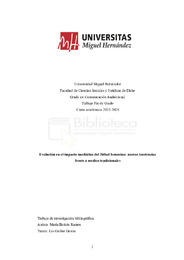Please use this identifier to cite or link to this item:
https://hdl.handle.net/11000/33266Full metadata record
| DC Field | Value | Language |
|---|---|---|
| dc.contributor.advisor | Gaibar Garcia, Lis | - |
| dc.contributor.author | Batista Ramos, María | - |
| dc.contributor.other | Departamentos de la UMH::Ciencias Sociales y Humanas | es_ES |
| dc.date.accessioned | 2024-09-20T10:31:55Z | - |
| dc.date.available | 2024-09-20T10:31:55Z | - |
| dc.date.created | 2024-06 | - |
| dc.identifier.uri | https://hdl.handle.net/11000/33266 | - |
| dc.description.abstract | El fútbol femenino ha estado tradicionalmente invisibilizado en los grandes medios de comunicación en comparación con el fútbol masculino. A través de una revisión bibliográfica, entrevistas semiestructuradas a personas expertas y una encuesta para conocer nuevos hábitos de consumo de este tipo de deporte, este estudio pretende realizar un acercamiento más actualizado al estado de la cuestión del impacto mediático del fútbol femenino en España. El resultado principal es que, a pesar de que el fútbol femenino sigue siendo minoritario en lo que apariciones en los medios tradicionales se refiere en comparación con el masculino, las redes sociales y los nuevos medios nativos digitales juegan un papel fundamental en la visibilidad del fútbol femenino. De esta manera, el cambio de paradigma social entra la juventud, y los esfuerzos de antecedentes, así como estrategias exitosas como el modelo de Inglaterra, contribuyen a un mejor y mayor reconocimiento de esta disciplina. | es_ES |
| dc.description.abstract | Women's soccer has traditionally been invisible in the mainstream media compared to men's soccer. Through a literature review, semi-structured interviews with experts and a survey to find out new consumption habits of this type of sport, this study aims to make a more updated approach to the state of the art of the media impact of women's soccer in Spain. The main result is that, despite the fact that women's soccer is still a minority in terms of appearances in traditional media compared to men's, social networks and new digital native media play a fundamental role in the visibility of women's soccer. In this way, the change of social paradigm among youth, and the efforts of background, as well as successful strategies such as the England model, contribute to a better and greater recognition of this discipline. | es_ES |
| dc.format | application/pdf | es_ES |
| dc.format.extent | 41 | es_ES |
| dc.language.iso | spa | es_ES |
| dc.publisher | Universidad Miguel Hernández de Elche | es_ES |
| dc.rights | info:eu-repo/semantics/openAccess | es_ES |
| dc.rights | Attribution-NonCommercial-NoDerivatives 4.0 Internacional | * |
| dc.rights.uri | http://creativecommons.org/licenses/by-nc-nd/4.0/ | * |
| dc.subject | Fútbol femenino | es_ES |
| dc.subject | Cobertura mediática | es_ES |
| dc.subject | Redes sociales | es_ES |
| dc.subject | Medios tradicionales | es_ES |
| dc.subject | Noticias deportivas | es_ES |
| dc.subject | Women’s football | es_ES |
| dc.subject | Media coverage | es_ES |
| dc.subject | Social media | es_ES |
| dc.subject | Tradicional media | es_ES |
| dc.subject | Sports news | es_ES |
| dc.subject.other | CDU::7 - Bellas artes::77 - Fotografía. Cinematografía | es_ES |
| dc.title | Evolución en el impacto mediático del fútbol femenino: nuevas tendencias frente a medios tradicionales | es_ES |
| dc.type | info:eu-repo/semantics/bachelorThesis | es_ES |

View/Open:
CAU_TFG_BATISTA_RAMOS_MARIA.pdf
3,14 MB
Adobe PDF
Share:
.png)
